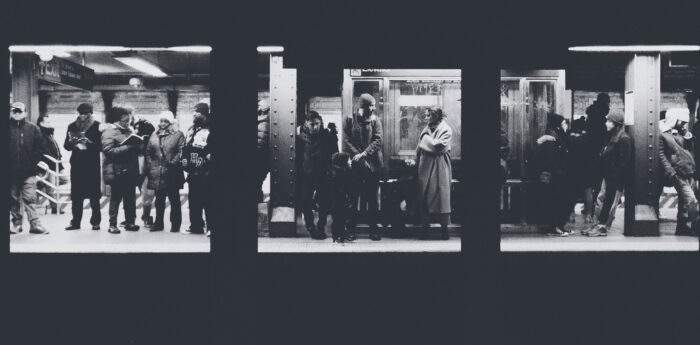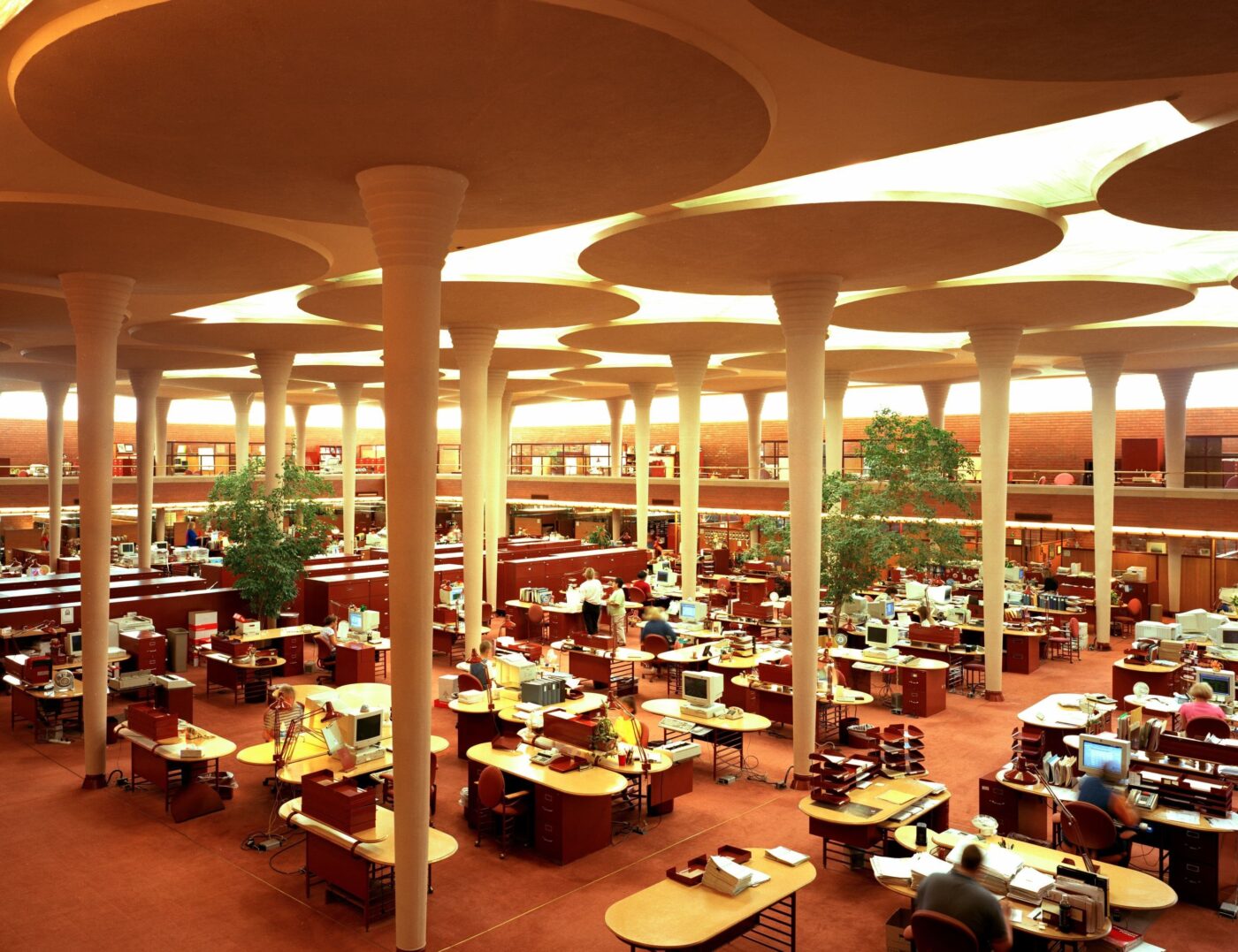
In turn, we use cookies to measure and obtain statistical data about the navigation of the users. You can configure and accept the use of the cookies, and modify your consent options, at any time.

It was not Robert Probst’s plan to become the originator of one of the most hated innovations in the history of office work. Although his most famous invention – a precursor to the cubicle called Action Office II (AO-II) – became associated with a specific kind of toxic work culture, Probst’s intentions were not to keep office workers slaving away in tiny stationary compartments. In fact, the AO-II was designed with ultimate flexibility and freedom in mind. It featured moveable display surfaces, standing rolltop desks, and shelves of varied height necessitating physical movement in an otherwise static desk job. Its adjustable walls gave office workers the ability to shape their workspace as they desired. It promised more freedom in work.
Contrast these lofty ideals for autonomous office workers with the regimented cubicled office-scapes depicted in much of late 20th century pop culture, at a time when workstations similar to the AO-II had come to dominate office layouts, particularly in the US. 30 years after its invention in 1968, the cubicle had become such a powerful symbol of soul-draining office labour that it spawned its own genre of cinema. ‘Cubicle movies’ like Fight Club, Office Space, Being John Malkovich, The Matrix and American Beauty shared the common demoninator of having their protagonists stowed away in dead-end jobs in some corner of a dreary office.
Of course the cubicle itself wasn’t the issue. Its success is as an example of what happens when progressively minded design meets a conservative management and work culture. What Probst had intended to become a tool to empower office workers not only became a prison for them, but a way for managers to maximise real estate value, thereby reinforcing the efficiency-obsessed approach to office work Probst had originally sought to combat. As he noted later in his life, the problem of cubicle office culture was not rooted in the design of the AO-II. It was that “Not all organisations are intelligent or progressive. Lots are run by crass people who can take the same kind of equipment and create hellholes”.
For good reason, cubicled office spaces have since fallen out of favour, replaced by new approaches to the organisation of white-collar work. Most offices nowadays follow open-plan designs meant to stimulate creativity and encourage face-to-face collaboration. Yet open plan offices are nothing new. They have been around since the blue-to-white collar migration of the workforce beginning in Western nations the mid-20th century. Early iterations were characterised by rows of desks in tightly packed spaces, simulating the assembly lines of manual industrial labour. Since then several variations and innovations have emerged, and practices like ‘hot desking’, ‘hoteling’, or ‘free seating’ have been introduced to encourage a more dynamic and collaborative flow of work, while minimising costs on rent due to the reduced amount of space and desks needed.
Then came the pandemic, which will doubtlessly be remembered as a watershed moment in the history of work. It marked a shift from workers clocking in 9-5 at the office to permanent remote work becoming widespread almost overnight. Once again, the question that drove Probst in his design of the AO-II – how control over the physical work environment impacts worker wellbeing and productivity – is now on the minds of both office workers and employers worldwide. A revolt is underway, and the open-plan office, along with the ways we organise work more generally, is under renewed scrutiny. Perhaps when trying to chart a path ahead, we should look to what Probst understood but failed to deliver all those years ago. His AO-II was in many ways a response to the detrimental effects of open-plan offices on worker wellbeing and productivity. He saw the office-scape of his day as a “daily scene of unfulfilled intentions and failed effort”.
The pandemic has called into question many things that weren’t previously thought of as major causes of concern. For one, the heightened hygiene awareness provoked by Covid-19 has revealed some of the overlooked downsides of open-plan offices with shared desks: the easy transmission of viruses – not just deadly ones but also more benign variants like the flu or the common cold. This begs the question how much employee downtime could be avoided if offices were designed to not be petri dishes of disease transmission.
More importantly, prolonged periods of working from home have made employees aware that 9-5 at the office may not be their preferred (or most productive) way of working. Before Covid-19, working from home was something you could do only if you had a good enough reason for it, lest you be accused of trying to waste time on the company dime. That stigma seems to have been erased at many workplaces, perhaps permanently.
Although working from home comes with its own set of challenges including frequent distractions and zoom-fatigue, it seems to be overwhelmingly favoured by most office employees. An eye-opening survey of office workers worldwide conducted at the height of the pandemic in 2021 by international staffing agency Robert Half found that 1 in 3 employees would quit their job if forced to go back to working at the office full-time after the pandemic.
Another survey, conducted around the same time among US office workers by LiveCareer, showed the 81% of responders enjoy working remotely, and 65% believe that remote work has positively affected their work-life balance. A newer study from February 2022 by Pew found that even after prolonged periods of lockdown, a majority of workers (61%) working from home now do so out of choice rather than necessity.
Ultimately, worker wellbeing at the workplace may be achieved by not going in at all – or at least having the option of working in the kind of isolation similar to that offered by the home. The pandemic may have revealed this fact, but it’s not exactly new knowledge. A study published in 2013 in the Journal of Environmental Psychology found that “enclosed private offices clearly outperform openplan layouts in most aspects of indoor environmental quality, particularly in acoustics, privacy and the proxemics issues”. The study further concludes that the benefits of enhanced “ease of interaction” among employees are smaller than the penalties of increased noise level and decreased privacy.
Other studies reach similar findings, with researchers having recently discovered that the cognitive performance of employees is noticeably better in cell offices compared to open-plan workspaces, suggesting that employers could benefit by providing their workers with isolated, quiet areas to perform cognitively demanding tasks.
Although science may support a shift to more private workspaces at the office, it’s unlikely that we will see the cubicle or private offices for workers make a comeback anytime soon. Instead, reaching the promise land of worker autonomy, creative stimulation, and productive co-working habits while also allowing for needed periods of deep focus may be as simple as continuing to provide employees with the opportunity to work from home, where they can exercise ultimate control over their physical surroundings – with the added benefit that it won’t break the bank for employers trying to save money on rent.
Peering further into the future, new innovations in communications technologies may contribute to making the open-plan office even more superfluous. The steady adoption of telework already supports new ways of doing office work apart – a development that has been hypercharged by the pandemic. It’s not unthinkable that seated deskwork on laptops will no longer be the main point of productivity a few decades from now. And with prospects of more work taking place in virtual worlds, it’s even conceivable that we won’t even need an office at all.

This is an article from “Entering the New Age of Work” (2022)
Get your copy here